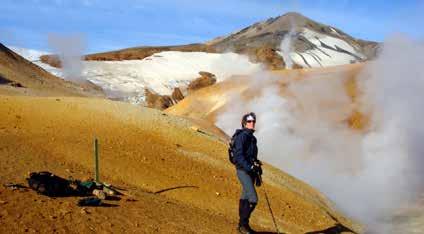
4 minute read
Between the Glaciers
Breathtaking experiences and stunning hiking treks in Kerlingarfjöll

If hiking is your passion, the challenge of new places is in your blood. This is one reason for the surge in popularity in hiking trips to Iceland. There are just so many varied hikes to take and various levels of difficulty.
Up past the classic tourist sites of Geysir and Gullfoss, the road reverts to gravel as it heads into the highlands of the interior along the Hvítá (White River), up between the Langjökull and Hofsjökull glaciers. This relatively flat territory, forming a large plateau named Kjölur (meaning keel of a vessel). Here, between these glaciers rises a group of mountains, hosting the third largest geothermal area in the interior: Kerlingarfjöll.
Kerlingarfjöll are 80 km from Gullfoss, partly on gravel roads that have been improved for normal vehicles. During the summer months, the Sterna bus company and SBA have regular services there.
This entire trip is one of superlatives as every aspect of the nature cries out for your attention. The different elements play with each other, creating a vista of constantly changing, shimmering colours and forms throughout the day and over the months. The pristine, pure, clean air and the thundering silence of the surrounding mountain peaks draws you into hiking its many trails. Plumes of steam rise from geothermal vents and hot springs over a landscape coloured red, yellow and green by the different minerals and natural chemicals.

Who is the old woman?
The name, ‘Kerlingarfjöll’ translates as ‘Old Woman’s Mountains’ and comes from folk tales telling how an old troll woman stayed out too late and didn’t make it to her home in the mountains before the sun rose and turned her to stone. A 25 metre-high tuff stone pillar, said to be the troll, gives the range its name. Other folk tales describe the area being used as a haven or sanctuary for robbers and outcasts.
An Oasis in the Desert
This would be an austere region were it not for the restaurant and cottages situated at Ásgarður, in the green valley at the north eastern end of the canyon leading from the main geothermal area, Hveradalir. They transform the hiking experience by providing comfortable accomodation for up to 100 people and good food both before the start and at the end of a long day’s hike.
Not only that, but the natural hot pool is a wonderful place to relax and soothe sore muscles. In the winter months, it gives the added experience of watching the Northern Lights as they sweep across the sky in a dance that can last for hours, with a totally different performance each



night against a backdrop of glistening mountains and glaciers.
It is one of the driest parts of the country yet, during the winter months, it is covered in snow, transforming the scene once again. This is the time to travel by superjeep as Kerlingarfjöll is a very interesting destination in the winter as well.
See From Sea to Sea
It is little wonder that Kerlingarfjöll is a popular place to stay in summer though, as many people love to enjoy the wonders of nature along with the peace and tranquility it offers. The area is big enough that its solitude is rarely interrupted by another hiker and yet, amazingly, there is mobile phone access, so you are never far from modern life, should you need to communicate.
From the peak of the 1477 metre-high Snækollur mountain, you can see the seas in both the north and south on a clear day, which makes the summit second to none when comparing the size of area one can see from it.

Formed in Fire
Born in a volcanic eruption, Kerlingarfjöll is a relatively young range of mountains, unusually created from ryolite, liparite and both dark and bright tuff stone about 10,000 years old. This is what gives it its constantly changing colouring, depending on the light, the sun and the time of day. When it was being created, there was a glacier covering the mid highlands. In some places, it seems tuff stone burst through the ice, becoming covered with lava.
Kerlingarfjöll is at the centre of a system of volcanoes, with one of the most powerful hot spring areas in Iceland. It is a very active geothermal area still, with plenty of warm streams and pools flowing out from different parts of the mountain range. Some of the geysirs have melted the glacial ice and created impressive arches, caves and ice rocks.
Melting Treasures
Geologists from many parts of the world come to see its treasures - some of which, according to Dr. Simon Carr of the Dept of Geography at Queen Mary College, University of London, could disappear in a matter of a couple of decades, making it all the more imperative to visit and enjoy its wonders while they are still there.
Until 2000, this used to be one of Iceland’s most popular destinations for a summer skiing school but since that time, no lifts have operated as the snows have melted and the glaciers retreated under the effects of the changing climate.
In Spring, the melting snow creates unusual sculptures, swelling the many streams that turn into rivers, flowing in different directions. Amongst them is the mighty Hvítá that gives the Gullfoss waterfall its power and makes it such a magnet for tourists.
Yet, it all begins here, in the area around Kerlingarfjöll. -ASF
Kerlingarfjöll
Árnessýsla - 801 Selfoss +354 664 7000










